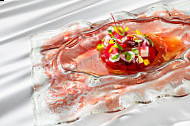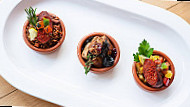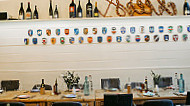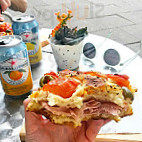Teléfono: +494030603222
Dirección: Museumstraße 23, 22765 Hamburg, Germany
Ciudad: Hamburg
Menú Platos: 15
Reseñas: 7
Sitio Web: http://www.schmidt-und-schmidtchen.de/
"today I would like to report once again on art and culture, but a little different from the hamburger railway station in front of the ! Nevertheless in the oldona museum, not all areas can be called barrier-free! it was created in 1863, even before it was convened a few years later by hamburg. you feel the maritime connection with the elements and a little the proud that the people who lived here centuries ago and sometimes worked physically hard. the alternating history of the region, which goes far beyond today's borders hamburgen, is full of reference to what it had coined. they can experience here in northern Germany with their different facets: crafts, tradition and maybe some might surprise, even as fruitful against, which is still known for the obstanbau – old land. to such a living are the houses with the equipment that they are both a model and close! these simple houses are nevertheless a product of paste that there is no longer in shape today. in such collections they are preserved as living rooms! pity that the time was no longer sufficient, because the oldona museum has other two things: jenish house, as well as house lühe ewer elfriede in the harbour övelgönne and heine house that I do not know. If it is desired, they can purchase a comicard that is not mentioned at all on the linked page: . for the art and culture museum, as it is officially said, are very slim 8.50 € due, which I personally have for very favorable filling offered here! Many of the muses I have visited in recent years and the North German land museum is called that. this “community” is closely linked to private collections that had presented this for the first time in 1863. in the then still Danish altona there were some enthusiastic who had gathered what they had and from their own belongings the alternating history of the place. those who are called in context I cannot escape. These include weapons, coins, paintings, everyday objects and others. Today, the focus is more in the areas I have mentioned. one of the highlights they should not miss are the galion figures on the cellar! the lighting creates a special atmosphere. Nevertheless, since in this part only very little natural light came, I had the impression that it could be somehow stronger. that is a subjective perception. another part of the building is that if you want to get to the historic building, it can only be reached by a very steep wooden staircase. after the inputs I found in the net, it should be unknown to me where another alternative should exist. the said “houses” – for example 17 different mediate, which had differentiated according to the region in which they were found. also comes that here a time span between the 17th 20th century is illustrated! so they can look forward to a varied band width. some are so small that I could not even make “equate” pictures! they belonged from the beginning when a corresponding building was built and opened in 1901! otto lehmann 1865 1951, the first director of the altona museum was considered very advanced in his life! in the floating no “dry knowing” but his opposite! for me it is quite remarkable that he had turned himself to the person to it! he was one of the first to follow more than a year founded Scandinavian “canister”. it was the first open-air museum in europa at all, in which a well-founded representation of such a building everyday with crafts and everything that is visually mediated with not only that, but also today by the interaction! in the form of dioramen was created at the time a novum, models and exhibits that could be traced how “something” works. as such I can touch those who could be touched, what is anything but natural! they were hand tools used to repair netzen. that may have changed. my partner stayed the models of the ships in memory. they and the nautical devices form a way to get information about the details that are completely alien to a “land rat”! what I missed a little that I wrote in the connected museum shop, there was no general guide about the complete collection: but this is not the reason for the evaluation. historically they find some hints at what was found in the architecture. from the sea animal world it becomes clear that even by such rather secondary details an attachment to the use is set! in a dedicated network was said that some of the parts originate from the cultivation that was realized on the occasion of the 250th anniversary of the altonas as an extension. like many other buildings this was destroyed during the Second World War to over 65%. in the 50s a contemporary building was forced. what was still present was integrated. since this time lies the focus of the collection on the art and culture of the region. another “cut” was a big brand in 1980, where some important historical objects were destroyed irreplaceably. what? this is not mentioned further on the linked hp. but what can be seen, speaks for itself! the first time I visited the oldona museum in the late 90 years, I was really amazed at how far the exhibition area is! the models of the houses I saw as one of the areas first. after that something happened to me very “conjured”: in another room I saw a person dressed for my taste completely “old-fashioned”. with her strict bed and knitting needles in the hands she could go smoothly as an “old farmer”. I made my pictures. after a past, it really surprised me that she had not even responded to my greeting. such a creepy woman, I've been thinking! Some after my own smile when I had to find that it was a wood doll. have also counted whether I have “pure” it again. after several decades can change a lot. it was also the case here. old toys still exist these were compiled to new art and wise. It is usually better to go in, because otherwise you can be disappointed as I was. but this is a subjective view. that is interested in the art history of the region and has fun in sea objects, I can put the house warm into the heart!"
Menú completo - 15 opciones
Todos los precios son estimaciones en menú.
Unser Frühstück
Extras
Ensaladas
Aperitivos
Modifier Pizza
Papa Al Horno
Platos De Huevo
Dirección

Reseñas
Hamburg

Hamburgo, una ciudad portuaria en el norte de Alemania, es conocida por su herencia marítima, su cultura vibrante, y platos locales como el Fischbrötchen y el Labskaus. Es una mezcla de encanto antiguo y ambiente moderno.
Categorías
-
Käse Una selección curada de quesos artesanales de todo el mundo, con sabores y texturas diversas que deleitan el paladar. Perfecto para compartir o disfrutar individualmente con los acompañamientos ideales.
-
Kaffee Disfruta de nuestra rica y aromática selección de café, preparada expertamente para despertar tus sentidos. Desde el clásico espresso hasta los lattes cremosos, descubre la mezcla perfecta para comenzar tu día con una nota llena de sabor. Ver carta
-
Hamburger Jugosas y deliciosas hamburguesas hechas con carne de res premium, ingredientes frescos y panes suaves. Personaliza tu hamburguesa con una amplia variedad de quesos, salsas y extras para una experiencia deliciosa.
-
Regionale Internationale Spezialitäten Explore una variada gama de especialidades internacionales regionales, desde platos asiáticos llenos de sabor hasta clásicos europeos sabrosos, que ofrecen un sabor de las auténticas tradiciones culinarias de todo el mundo.











